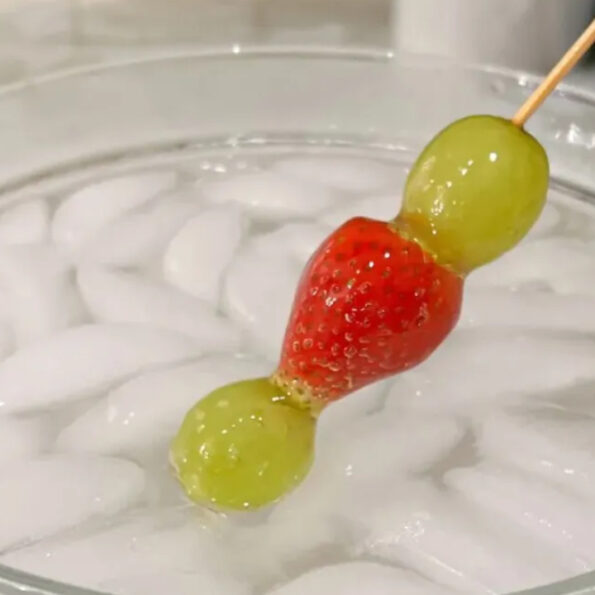Tanghulu recipe

Tanghulu, also known as bingtanghulu, is a traditional Chinese snack consisting of skewered fruits coated in a hard candy shell. Originating in northern China, this sweet treat has captured the hearts of many with its perfect balance of tart and sweet flavors. In this article, we will explore the history, cultural significance, variations, and a step-by-step guide to making Tanghulu at home.
History and Origins
Ancient Beginnings
- Discuss the origins of Tanghulu in the Song Dynasty (960-1279 AD).
- Mention its initial medicinal uses, believed to aid digestion and boost immunity.
Evolution Over Centuries
- Trace the evolution of Tanghulu from an imperial treat to a popular street food.
- Highlight its spread across different regions in China and adaptations in recipes.
Cultural Significance
Symbolism and Festivals
- Explain the symbolism of Tanghulu, often associated with happiness and prosperity.
- Describe its role in Chinese New Year and other festivals.
Pop Culture and Media
- Discuss Tanghulu’s appearance in Chinese literature, movies, and TV shows.
- Mention how it has become a nostalgic treat for many Chinese people.
Variations and Regional Differences
Traditional Hawthorn Berries
- Describe the original recipe using hawthorn berries.
- Explain why hawthorn berries were chosen and their health benefits.
Modern Twists
- Explore the various fruits now used, such as strawberries, grapes, and oranges.
- Discuss regional variations and the introduction of new ingredients like nuts and seeds.
Ingredients and Tools
Essential Ingredients
- List the basic ingredients needed: fruits, sugar, water, and optional flavorings.
- Provide tips on selecting the best fruits for Tanghulu.
Tools and Equipment
- Detail the tools required: skewers, candy thermometer, saucepan, and baking sheet.
- Explain the importance of each tool in achieving the perfect candy coating.
Step-by-Step Recipe
Preparation
- Clean and Skewer the Fruits
- Wash the fruits thoroughly and pat them dry.
- Skewer the fruits, ensuring they are evenly spaced.
- Prepare the Sugar Syrup
- Combine sugar and water in a saucepan over medium heat.
- Stir until the sugar dissolves and the mixture reaches 150°C (300°F).
- Coating the Fruits
- Dip the skewered fruits into the hot syrup, ensuring an even coating.
- Place the coated fruits on a baking sheet to cool and harden.
- Final Touches
- Optionally, sprinkle with sesame seeds or nuts before the syrup hardens.
- Allow the Tanghulu to cool completely before serving.
Tips and Tricks
Achieving the Perfect Crunch
- Provide tips on how to avoid common pitfalls, such as crystallization and burning.
- Explain the importance of temperature control and timing.
Flavor Enhancements
- Suggest ways to infuse the syrup with flavors like ginger, cinnamon, or vanilla.
- Offer ideas for garnishes and pairings.
Serving Suggestions
Traditional Presentation
- Describe how Tanghulu is traditionally served on the streets of China.
- Offer suggestions for plating and presentation at home.
Pairing with Other Desserts
- Suggest complementary desserts and drinks that pair well with Tanghulu.
- Include ideas for incorporating Tanghulu into dessert platters and buffets.
Health Benefits and Nutritional Information
Nutritional Breakdown
- Provide a detailed nutritional analysis of Tanghulu.
- Discuss the health benefits of the fruits used and the impact of the candy coating.
Moderation and Enjoyment
- Offer advice on enjoying Tanghulu in moderation as part of a balanced diet.
- Highlight the importance of portion control given the high sugar content.
Tanghulu Around the World
Global Adaptations
- Explore how Tanghulu has been adapted and embraced in other cultures.
- Compare Tanghulu to similar candied fruit treats from different cuisines.
Modern Popularity
- Discuss the growing popularity of Tanghulu outside of China, especially in social media.
- Mention notable international variations and innovations.
Tanghulu is more than just a sweet treat; it is a cultural icon with a rich history and a symbol of joy. Whether enjoyed traditionally or with modern twists, Tanghulu continues to delight people of all ages. By following this comprehensive guide, you can bring a piece of Chinese tradition into your home and savor the delightful crunch of this beloved candied fruit.
Tanghulu, also known as bingtanghulu, is a traditional Chinese snack consisting of skewered fruits coated in a hard candy shell. Originating in Northern China, this sweet treat has captured the hearts of many with its perfect balance of tart and sweet flavors. In this article, we will explore the history, cultural significance, variations, and a step-by-step guide to making Tanghulu at home.
- 1 pound strawberries, grapes, or other fruit of choice (~30 pieces)
- 2 white sugar
- 1 cup water
- Step-by-Step Recipe
-
Wash the fruit and pat it dry. Remove leaves, stems, or any inedible parts. Place fruit on skewers. I recommend 3 pieces or less per skewer, so it is easier to work with.
-
In a small pot on low to medium heat, add sugar and water. Do not stir. Bring to a boil and simmer until it is thick like syrup and amber in color (~300°F). This takes about 10–20 minutes.
-
Test the temperature of the syrup by drizzling a spoonful into an ice bath. If it hardens within seconds and cracks when bent, then it is ready.
-
Quickly dip the fruit skewers in syrup, then swirl to evenly coat a thin layer. Immediately dip the skewer into an ice water bath to cool and harden the sugar coating.
-
Place the skewer on a plate, repeat with the remaining (work fast so the sugar doesn't burn), and enjoy!
-
Tips and Tricks
Achieving the Perfect Crunch
Provide tips on how to avoid common pitfalls, such as crystallization and burning.
Explain the importance of temperature control and timing.
Flavor Enhancements
Suggest ways to infuse the syrup with flavors like ginger, cinnamon, or vanilla.
Offer ideas for garnishes and pairings.